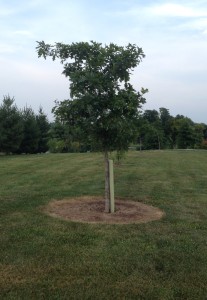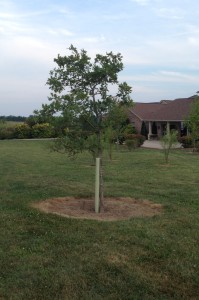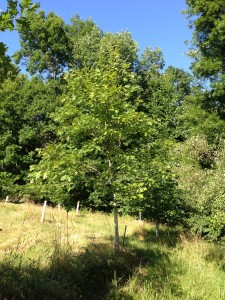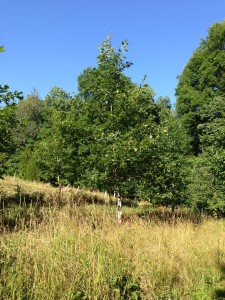In spring, 2009 a gentleman in Kentucky planted trees both in his woods and in his newly landscaped yard. In both cases he planted red oak (Quercus rubra) – so already he gets bonus points for bucking the anti-oak bias in the landscaping industry and planting oaks not just as wildlife habitat in the woods but as fast growing landscape trees.
In the forest, since he was planting a large number of trees, he purchased 12 inch tall bare root seedlings from the state of Kentucky forest tree nursery, and protected them with 4 foot tall tree tubes.
In his yard, since he wanted more immediate visual impact, and on the advice of his landscape designer, he planted 7 foot tall trees grown in 20 gallon pots. In other words these trees had a head start of several years in age, 6 feet in height, and about 2 inches in caliper. And, of course, these trees cost well over $150 each.
The distance between his yard and the woods is not great, and the soil types are very similar.
So how do these two planting methods compare, now in the sixth growing season since planting? You might be surprised. First here’s what the two 20 gallon trees planted in the yard look like:

Red oak, planted spring 2009 as a 7 foot tall, 20 gallon tree. The four foot tree tube leaning against the trunk was placed there before the photo was taken in order to show scale. Tree is now approximately 12 feet tall.

The second of two 20 gallon red oaks planted in the yard in spring 2009. This one is now approximately 11 feet tall.
Now let’s take a look at the red oaks planted as tiny seedlings that same spring:

Red oak planted as a 12 inch bare root seedling in spring, 2009. Tree is now approximately 17 feet tall.

Another red oak planted as a 12 inch bare root seedling in spring 2009. As of August, 2014 the tree is about 17 feet tall.
The woodland red oaks planted as seedlings are now splitting the walls of the tree tubes, meaning they have reached 3-1/2″ in diameter at the base – or more.
Twenty five years ago I started promoting tree tubes because I was convinced that trees are best planted as small seedlings, and that given today’s unnaturally high deer populations seedling trees need the protection of tree tubes.
The larger the tree you purchase for planting, the more likely it is that the root system will be misshapen, maimed and mangled during nursery production, harvesting, sitting in stock at the nursery, and during planting. The larger the tree you plant, the greater the transplant shock, and the longer the period of time required to regain a healthy root/top balance and begin growing again.
… so why is there a multi-gajillion dollar industry based on selling large landscape trees for hundreds of dollars when folks could achieve much better results in a small seedling and plastic tree tube? Follow the money.
Every time this gentleman sees those two red oaks in his yard he wishes he had simply planted two seedlings with tree tubes instead. He wouldn’t have had the same instant visual impact, but he wouldn’t have had to wait long – and the trees would be a whole lot taller and thicker by now!
When tree tube users plant trees in their yards they often plant seedlings with tree tubes, rather than spending hundreds of dollars on large trees. Planting seedlings gives them a much wider selection of species to plant (including a huge array of oaks!), and results in faster, healthier growth as well as (I’m utterly convinced) longer lived trees.
